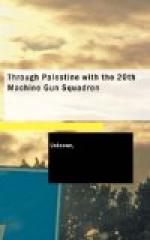Just then the Turk got some field guns in action and sent a few shells over at us, the very first one falling right on top of Brigade Headquarters; fortunately, it did not hit anyone!
“No. 3” Section accompanied the Poona Horse on the left flank, and there had some “practice” on the road, similar to the other sections. It was joined there by “D” Sub-section, Nos. 1 and 2 having come out of action, as there were no further “targets” for them. “No. 1” Section was now sent, with one squadron of Deccan Horse, to occupy a hill south-east of Ashrafie and due north of the position they had been holding. Machine-gun fire was met with half a mile from the hill, but only one casualty was sustained (Pte. Knott, wounded). The Deccan Horse charged the hill, and the section came in action on the top of it, firing upon the retreating enemy and silencing two of their machine-guns. The groves round Ashrafie, and the road to the east, were “traversed” and a regiment of Turkish cavalry, which was in the groves, at length sent a representative under a white flag expressing a desire to surrender. Outposts were now put out, and the remainder of the Brigade was moved up to Ashrafie and watered, staying in that vicinity for the night.
Some splendid grapes and other minor luxuries were obtained at the village and were very acceptable. That night the country was lit up for miles around, and the air resounded with explosion after explosion by the destruction of large ammunition dumps and other stores by the Turks. “No. 3” Section remained with the outposts, owing to the fact that two orderlies who had been sent out were unable to find them.
In the early morning they obtained some splendid “targets” on the road, against the tail of the Turkish force which was being driven along by the 4th Division and the Hedjaz troops. Close on their heels came Lieut.-Col. Lawrence and Major Sinclair of the Sherifian Army in a car. They would have been fired on, but for the fact that our own troops were in the danger zone. Their identity was discovered in time, however, and Major Davies, who had just arrived to see how “No. 3” Section was faring, went down and spoke to them.
WE ENTER DAMASCUS.
At 07.30 the Australians having got round to the north of the city, our Brigade moved through Ashrafie and groves eastward to the road, so frequently referred to above, and marching along it, passed Meidan, at 09.30 entering Damascus—just 12 days from the start of operations, it being then October 1st 1918. The approximate distance covered by the Division was 215 miles, the distance due north of our old Line 104 miles.
Probably the town of Damascus proved to be disappointing to the majority of the troops. It was interesting, certainly, but those who had been long in the East did not find the expression “Eastern splendour” realised here, any more than in other towns they had seen; such an idea would seem to exist only in the minds of those who have never been “out East”. The natives, on the whole, seemed pleased to see us, the victors, and frequently cheered, while Major L.F. St. J. Davies, M.C., at the head of the Squadron (which followed the Poona Horse, the leading regiment, thus being the first white troops), was exceedingly popular.




